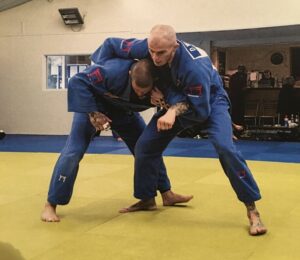
I listened to the zoom chat between Roger Gracie and John Danaher a few weeks back after my friend, RGA black belt Chris Cleere, forwarded it onto me.
Interestingly, Danaher (32 mins 20 secs in), puts forward the idea that one of the next great hurdles of BJJ progression is the development of quality and competent stand up games, exclusively specific for BJJ competition. Personally, I really believe that, for the gi, this will be the beginning of the death of the square feet rounded back stance that is so very common.
I agree with many points that Danaher made, I’ll talk mainly about the comments regarding Judo. I have some experience of wrestling in the UK and in the former soviet states but don’t consider myself experienced enough to comment with conviction about anything outside of the gi.
It will be useful here to first talk briefly about current international Judo. I won’t preach that it’s worthwhile for a Jiu-jitsu practitioner to head down to any old local Judo club, I don’t think that that is the answer at all. Do your research. A fair percentage of Judo people, particularly older, are still ignorant to the effectiveness of BJJ and how the rule sets actually make a VERY big difference to a contest. Better to just get another night of Jits in than to head to one of those clubs. Make phone calls and emails to make sure you are going to get what you need.

After the break up of the Soviet Union international Judo changed forever. All of the ex soviet states take a keen interest in grappling, of which most have their own traditional styles of wrestling; Chidaoba in Georgia, Kurash in Uzbekistan for example. What we had from the 1996 Olympic Games onwards was a real influx of what was know then as “unorthodox styles,” which became more and more common due to their consistent proved application in contest. Today, modern Judo is a real mixture and if, say, Sambo style techniques are what you are after then most can be found within Judo. I’d go so far to say that in the UK where the Sambo community is very small, you would find the majority of the techniques that may be of interest instructed well, and probably better, at a competitive Judo club. That’s not a slate at another art, just an emphasis on the current state of international competitive Judo.
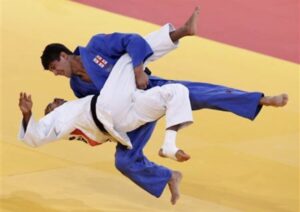
More countries compete at Judo than any other sport at the Olympics, athletics included. With it’s Olympic status many of these former soviet states push their traditional wrestlers into Judo, Russia in particular. Contrary to popular belief many clubs still teach the leg grab style techniques, they are also still required for gradings. I began Judo in 1994, leg grabs were removed from Judo in 2012, I have nearly 20 years experience of grappling in the gi where grabbing the legs were permitted and, I am still a very young, relatively inexperienced coach. There are many others with far more experience than I. A real wealth of knowledge up and down the country if you are willing to search it out.
It is worth adding that however dominant the physical East European and Central Asian nations have become the Japanese, with their mostly traditional style, are still the worlds top nation. Personally, I believe the best stand up for BJJ lies in a stripped down mixture of these 2 styles, adding in the wrestling style techniques and defences that are already taught well in most BJJ clubs. Personal specific guard pulls for those favouring a bottom game also.

I like the approach that Danaher takes regards to building a system of jiu-jitsu. I take a lot from the content that he regularly puts out. Tried and tested methods only, research and experiment, keeping only what is useful to the individual. I believe this beginning is how the best stand up system for BJJ shall be built. I feel Danaher may have overlooked a few key areas regarding Judo however. He talks specifically about “Judo technique” a number of times in the discussion but no mention of the HUGELY important interlinking system that builds up to the throw, knockdown or takedown: a solid stance, risk minimal dynamic posture and movement, gripping, where and how to apply tension on the kit etc.

The techniques that Danaher mentions, the side circle throw (yoko-tomoe-nage) and the corner reversal (sumi-gaeshi) are undeniably two of the most applicable throws that transfer well between the sports. Both, however, require a decent grip, getting the opponent dominated, moving and correct tension. Even these areas of Judo are not in the syllabuses, taught only by those understanding the foundations of fighting Judo. It is these areas that will actually, I believe, be of most benefit to the Jiu-jitsu player. What BJJ is brilliant at, and I’ve learned so much from, is disregarding what is not so useful. I’d go so far to say that 90% of what is taught in Judo clubs and syllabuses is not applicable to the Jiu-jitsu practitioner but, in that remaining 10%, lies truly valuable, simple and effective content. Those able to isolate and practice such content shall reap the rewards of their research and labor.
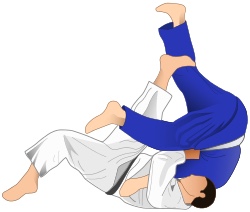
That rule is the same the other way around, the majority of Jiu-jitsu is not really applicable to a Judo contest. That small percentage that is though has been proving its worth; the fundamental movements, basic attacks from the guard. Travis Stevens popularised the over under pass which is now becoming more frequently used. I think the next big push will be improved work from the half guard position in Judo, which can obviously link in with the over under pass too. The copy and paste method is not the best approach for cross training, agreed. I think for the initial improvement of both sports it is vital that the coaches become better versed in both arts but, primarily, from a selective approach. Eventually, we’d hope that the key, transferable aspects of the two sports would have been integrated well and the benefits for cross training would be less. That beneficial knowledge having already been attained previously. There is definitely a place for a “Jiu-jitsu for Judo” syllabus that would work remarkably well too. Most high level British Judo players cross train BJJ.
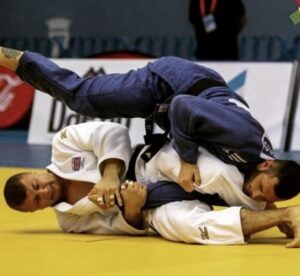
Regards to stand up I think the important question to ask is what do we want out of it? Surely if we desire to end up underneath the guard pull is always the option. That hurt to type (-; Largely, not always but mainly, the dominant stand up game is sought after by the individual favouring or seeking a top position. So, minimum requirement, let’s say, ending up in, or just out of, someone’s guard; better still in half guard, better again side control or north and south, even better still the mount or, at best, to have the back. I have some really able BJJ players on my (Judo) session that I run at Camberley Judo Club. As well as they have been improving at their knock downs and throwing, when I talk to them about how the training is improving their stand up on BJJ sessions, the typical reply is “I close the space, grip up and start a little movement and, before I know it, they feel threatened and try and pull guard.” Minimum requirement met as far as I’m concerned there.
Let’s look at it all from a contest perspective:

The referee says start. What’s the first thing that we do? We will, when we are somewhere out of range of gripping and shoots, get into stance. To utilise the use of the gi then we must be assertive to move and obtain the grip, this alone can nullify all attacks to the legs. We can pop in and out of range of shoots too. This is the base of everything that will happen on the feet. Get it wrong and we are in trouble from the start.
We don’t have to be intimidated of the single when standing with one foot forward, simple throws like the corner reversal (sumi-gaeshi) counter it well, the harder they go for the leg the easier it is to throw them; Sambo wrestlers utilise this technique VERY well. We also call the stance “dynamic posture,” dynamic in movement, attack and defence. Get this sorted and we should never be lapel dragged again; our centre of mass (weight) firmly inside the base of support (space between the feet). Yes, by standing up slightly higher we will be taken down more as we start but, as Roger Gracie states in this talk, with practice it will quickly improve. As Danaher also discusses, don’t get stuck in a non-developmental mindset for the sake of maybe getting taken down by a lower belt club mate for a few weeks. It won’t take too long.

As we move around the opponent we want to stay as close to stance as possible, never too wide or too close with the feet. Consider the connection with the floor, using the floor to drive off for all directions of movement, particularly valuable for pushing and pulling when gripped up. Getting out of the way of shoots becomes far easier, driving off the front foot to move backwards and get out of range. For those favouring the shoots then closing the space becomes much more accomplishable, sink lower in the legs for depth. The square feet, straight legs and rounded back being good for little to nothing.
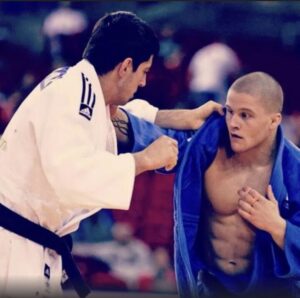
This alone is the great divider between the two styles, gi and no-gi. The obvious principle that if the opponent can’t obtain purchase on the kit, or a securer area of the body, then we will be immensely difficult to be taken to the floor into a less favourable position.
Never think about gripping the kit initially. Under the white hot heat of contest if we snatch at the kit and the opponent moves an inch then there is a strong chance we won’t get the grip. Think about connection with the body, if we want the bottom of the sleeve (to nullify the opponent’s hand) for example, then we will, with the palm of our hand, strike the wrist. We then know that in between our hand and their wrist the sleeve shall be. We don’t have to throw a Mike Tyson hook, connection alone will be enough, it is useful to let the opponent know that they are in a physical match though. Gripping is where we will create what is so very valuable for our stand up, tension.
Tension:
This is the most undervalued, under appreciated and largely unknown area of stand up in the gi, even within a lot of the Judo and Sambo circles. Tension is VERY important for all throws but I’ll use 2 examples that are the most beneficial to contest BJJ:
1-Tension on the collar to maintain distance and control
All tension starts from the stance, so for this example it will start from our back foot. Pressing off the floor to create a small amount of push we shall, after obtaining the collar, push it over the shoulder as opposed to the chest. If we think of the point of tension as just over the shoulder then we shall be able to keep the space fairly easily, following that point of tension down if the opponent goes for the legs. Roger Gracie himself used this in a real dominant fashion in his victory over Marcus Buchecha at the Gracie Pro back in 2017.
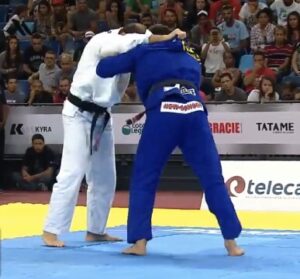
2- Drag! Drag! Drag!
The beauty of the kit makes pulling the opponent as much, if not more, effective than pushing. A real difference from no-gi. Once gripped up keep pushing hard off the front foot, utilising the full body to drag. Think about how we would pull a car if a rope was wrapped around the front bumper, same principle. The point of tension very much on the front foot. This then allows for the most simple example of the action reaction principle, pushing the opponent forcing them to push back, then using their push to pull them forward. Lapel pull down. This pulling action, and I can’t stress this more, is VITAL for throws like the corner reversal (sumi-gaeshi). Without the pull and breaking down of the opponent’s posture then the throw very much becomes a dive under and hope, as opposed to, projecting the opponent over once having them dominated.
At this point, or any before, if the opponent has attempted to pull guard then objective completed. I must admit when I first started Jiu-jitsu back in 2008 that this used to frustrate me as, coming in with a Judo mindset, I wanted to smash people over. As Danaher says though that is not at all the goal, the end position being the only thing that counts. End up on top then job done.
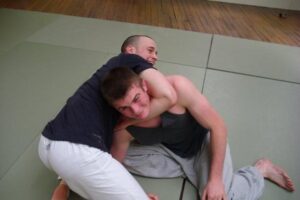
Techniques:
As many say, and I concur, if a player is coming into a Judo session to improve their stand up for BJJ then nothing which involves turning the back is worth looking at. I had a larger influx of BJJ players attending my class for the month after Jeff Lawson scored that standing shoulder throw, arm lock transition at Polaris 4. After 4-5 weeks many came to the realisation that performing said technique is extremely difficult and, under a BJJ ruleset, incredibly dangerous for anyone without years of Judo training like Lawson. It takes a lot of regular, rigorous practice to confidently pull off techniques like that, just like it does to develop a solid ground game. If inexperienced at stand up I’d go even further than to say that they are not only not worthwhile looking at but actually hinder the practitioner. Putting them at risk and making decision making more difficult. Sacrifice throws like corner reversal and the side circle throw, basic foot attacks, small knock downs and chops, Sambo-esque style ankle picks and leg grab pick ups, singles and doubles. That is the really applicable stuff. Developing the interlinking system and 2-3 of these attacks would leave an individual with a strong ability to take the contest from standing to where they want it on the floor.
Personally, as I focus to train and compete more in Jiu-jitsu, I look forward to watching more clubs develop their own systematic methods of teaching effective and specific stand up to their players. I understand that some already do. As discussed earlier, keeping only the effective maneuverers is something the sport does remarkably well, probably better than all the other grappling arts. With these efficient training methods I don’t think loads of time needs to be dedicated to the stand up work. The time most contests are spent on the feet, should be relative to the amount of time dedicated to its training.
BJJ grows more exciting and dynamic each year, I don’t think it will be long at all before the same will be said more regularly for the standing section of competitive matches. However, after everything said, I believe the really big question will be, how much will, or will not, improved stand up reflect on the outcome of contests?
DON’T FORGET TO SIGN UP FOR MY FREE WEEKLY NEWSLETTER
THE GRAPPLER’S WEEKLY WEIGH IN

